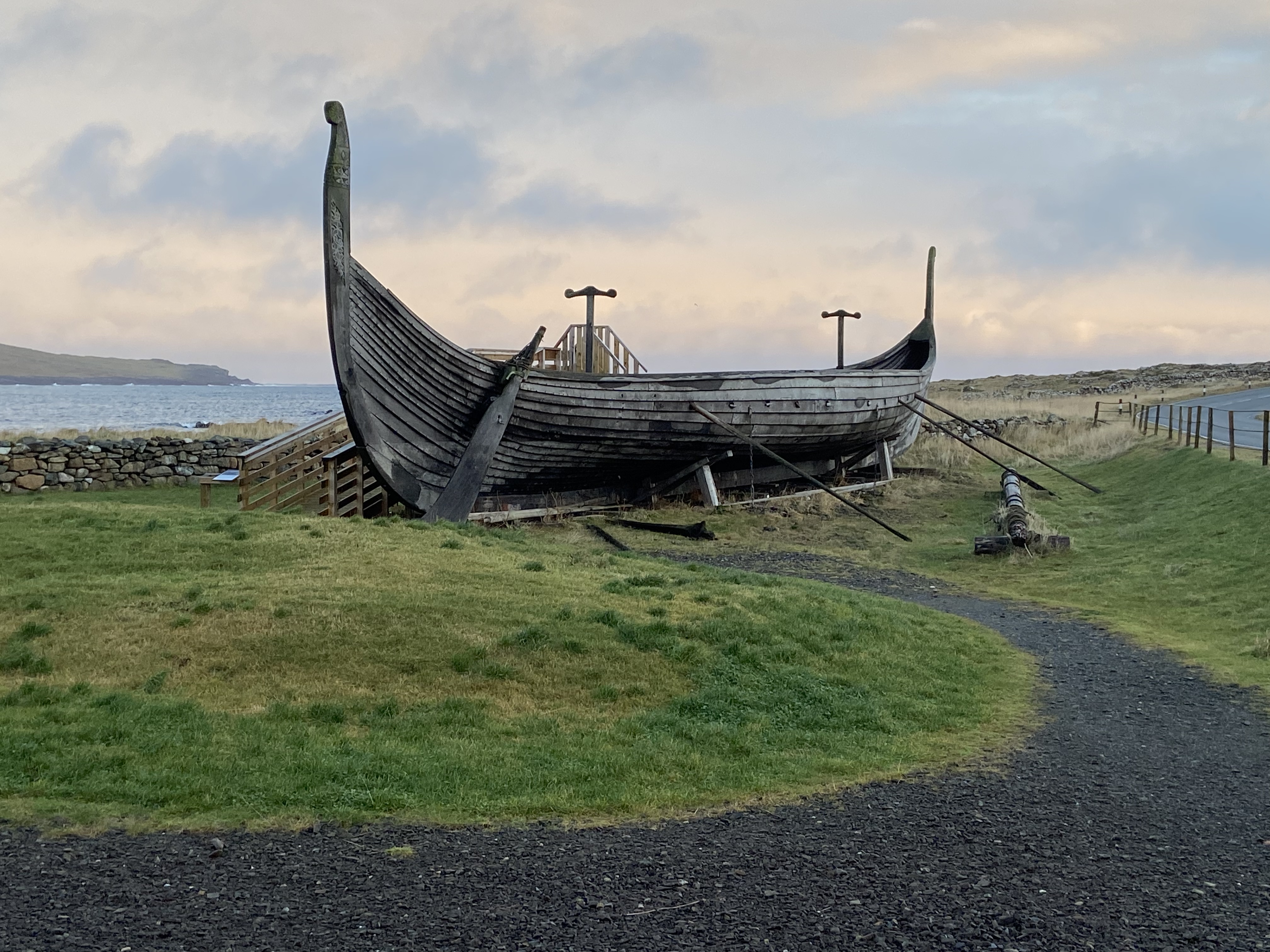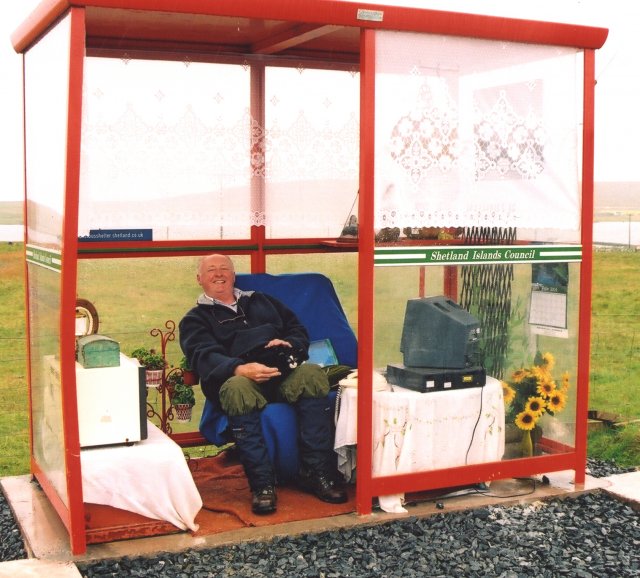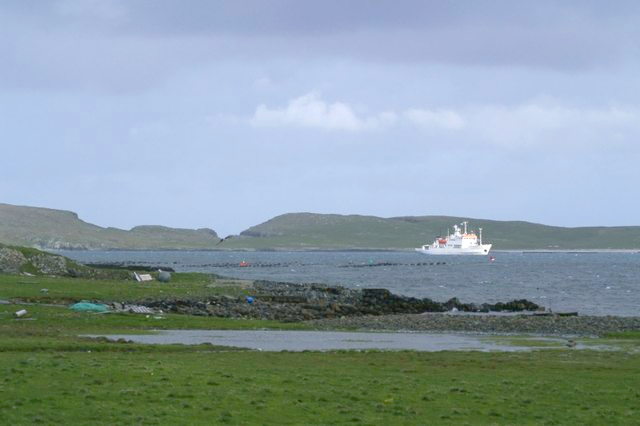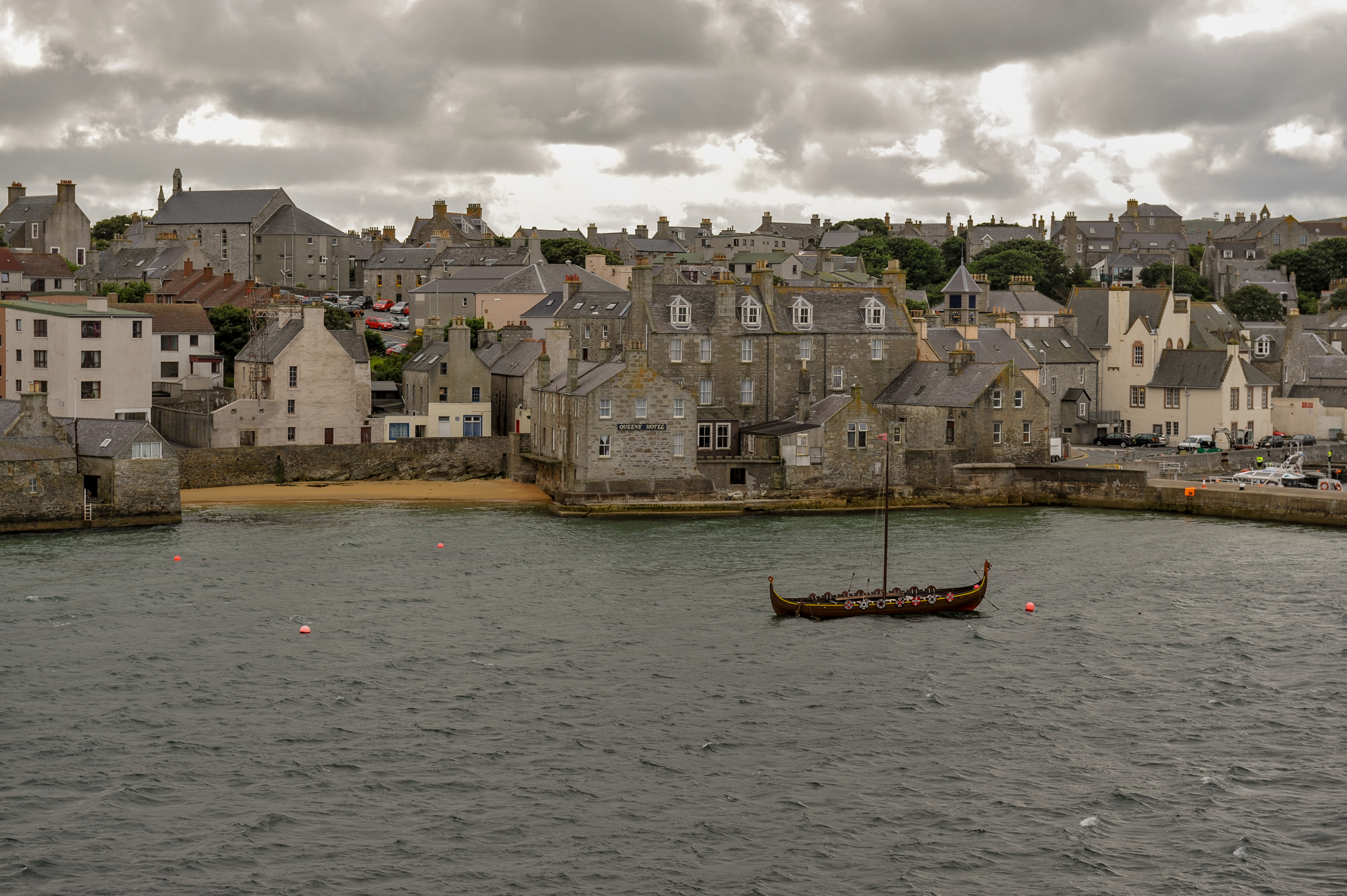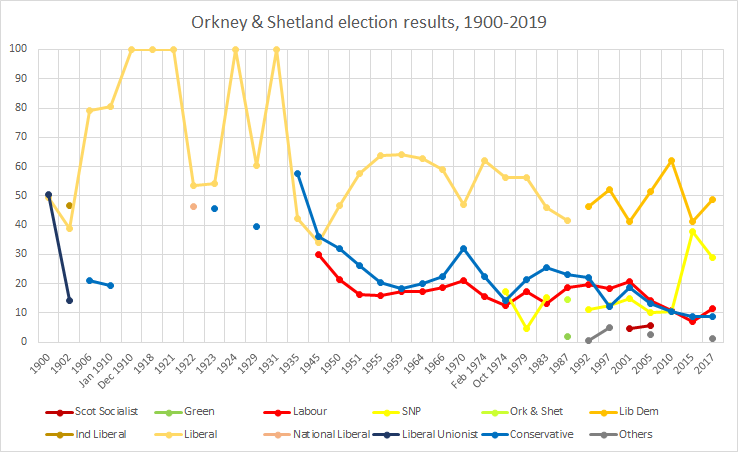|
Baltasound
Baltasound (or Baltasund) is the largest settlement on the island of Unst in Shetland, Scotland. It comes from the Old Norse man's name Balti (Baltisund). Unst is the most northerly inhabited island in the United Kingdom. The village lies halfway along the island's east coast on a sheltered bay called Balta Sound. Baltasound was formerly the most important herring port in Shetland. In 1902 its catch exceeded that of the Shetland capital Lerwick. The herring trade declined rapidly after 1905 but the physical remains of the herring boom remained long after. Baltasound was the home of the noted Victorian botanist Thomas Edmondston, who was born at Buness House where his uncle, also called Thomas, was the laird. A memorial stone erected outside the house by the elder Thomas Edmondston commemorates scientific studies undertaken there by the French physicist Jean-Baptiste Biot. Baltasound can also lay claim to the most northerly "wood" in the British Isles, although it is not very ... [...More Info...] [...Related Items...] OR: [Wikipedia] [Google] [Baidu] |
Unst Airport
Unst (; sco, Unst; nrn, Ønst) is one of the North Isles of the Shetland Islands, Scotland. It is the northernmost of the inhabited British Isles and is the third-largest island in Shetland after Mainland and Yell. It has an area of . Unst is largely grassland, with coastal cliffs. Its main village is Baltasound, formerly the second-largest herring fishing port after Lerwick and now the location of a leisure centre and the island's airport. Other settlements include Uyeasound, home to Greenwell's Booth (a Hanseatic warehouse) and Muness Castle (built in 1598 and sacked by pirates in 1627); and Haroldswick, location of a boat museum and a heritage centre. Etymology There are three island names in Shetland of unknown and possibly pre-Celtic origin: Unst, Fetlar and Yell. The earliest recorded forms of these three names do carry Norse meanings: ''Fetlar'' is the plural of ''fetill'' and means "shoulder-straps", ''Ǫmstr'' is "corn-stack" and ''í Ála'' is from ''ál'' meanin ... [...More Info...] [...Related Items...] OR: [Wikipedia] [Google] [Baidu] |
Unst
Unst (; sco, Unst; nrn, Ønst) is one of the North Isles of the Shetland Islands, Scotland. It is the northernmost of the inhabited British Isles and is the third-largest island in Shetland after Mainland and Yell. It has an area of . Unst is largely grassland, with coastal cliffs. Its main village is Baltasound, formerly the second-largest herring fishing port after Lerwick and now the location of a leisure centre and the island's airport. Other settlements include Uyeasound, home to Greenwell's Booth (a Hanseatic warehouse) and Muness Castle (built in 1598 and sacked by pirates in 1627); and Haroldswick, location of a boat museum and a heritage centre. Etymology There are three island names in Shetland of unknown and possibly pre-Celtic origin: Unst, Fetlar and Yell. The earliest recorded forms of these three names do carry Norse meanings: ''Fetlar'' is the plural of ''fetill'' and means "shoulder-straps", ''Ǫmstr'' is "corn-stack" and ''í Ála'' is from ''ál'' ... [...More Info...] [...Related Items...] OR: [Wikipedia] [Google] [Baidu] |
Unst Bus Shelter
The Unst Bus Shelter, also known as Bobby's Bus Shelter, is a bus shelter and bus stop near the village of Baltasound, on the isle of Unst, Shetland Islands, Scotland. It is maintained by the Shetland Islands Council. It is located on the main road across Unst - the A968 - which runs between Belmont and Haroldswick. The name "Bobby's Bus Shelter" honours Bobby Macaulay, a child who used to cycle to the shelter in the mornings to catch the bus to school. The local council had plans to remove the bus shelter in 1996, but after the seven-year-old sent them a letter asking them not to and explaining that the shelter is where he kept his bike while at school, the council left it there and furnished it. The shelter is equipped with a sofa and a television. It is furnished and redecorated periodically. For example, in 2010 it was given World Cup themed decoration due to Macaulay's visit to South Africa to see the 2010 FIFA World Cup , image = 2010 FIFA World Cup.svg , ... [...More Info...] [...Related Items...] OR: [Wikipedia] [Google] [Baidu] |
Hagdale Chromate Railway
The Hagdale Chromate Railway was a narrow-gauge railway on the Isle of Unst, in the Shetland Islands. Built in 1907, it connected the chromite quarries at Hagdale with a pier at Baltasound Baltasound (or Baltasund) is the largest settlement on the island of Unst in Shetland, Scotland. It comes from the Old Norse man's name Balti (Baltisund). Unst is the most northerly inhabited island in the United Kingdom. The village lies halfwa .... None of Shetland's few narrow-gauge railways were preserved. References * Railways on Scottish Islands Pre-grouping British railway companies Closed railway lines in Scotland 2 ft 6 in gauge railways in Scotland Railway lines opened in 1907 Transport in Shetland 1907 establishments in Scotland Unst {{Scotland-rail-transport-stub ... [...More Info...] [...Related Items...] OR: [Wikipedia] [Google] [Baidu] |
Shetland
Shetland, also called the Shetland Islands and formerly Zetland, is a subarctic archipelago in Scotland lying between Orkney, the Faroe Islands and Norway. It is the northernmost region of the United Kingdom. The islands lie about to the northeast of Orkney, from mainland Scotland and west of Norway. They form part of the border between the Atlantic Ocean to the west and the North Sea to the east. Their total area is ,Shetland Islands Council (2012) p. 4 and the population totalled 22,920 in 2019. The islands comprise the Shetland (Scottish Parliament constituency), Shetland constituency of the Scottish Parliament. The local authority, the Shetland Islands Council, is one of the 32 council areas of Scotland. The islands' administrative centre and only burgh is Lerwick, which has been the capital of Shetland since 1708, before which time the capital was Scalloway. The archipelago has an oceanic climate, complex geology, rugged coastline, and many low, rolling hills. The lar ... [...More Info...] [...Related Items...] OR: [Wikipedia] [Google] [Baidu] |
Balta Sound
Balta Sound is a sound (inlet) on the east coast of the island of Unst in the Shetland Islands, Scotland. The sound is sheltered from the North Sea to the east by the uninhabited island of Balta. The settlement at the west of the sound is Baltasound. On 12 March 1917, the World War I British E-class submarine was heading out of Balta Sound on patrol when it struck a naval mine laid by German U-boat . It was sunk in the channel between the islands of Huney and Balta with the loss of the entire crew. The site of the wreck is now designated as a war grave A war grave is a burial place for members of the armed forces or civilians who died during military campaigns or operations. Definition The term "war grave" does not only apply to graves: ships sunk during wartime are often considered to b .... Sounds of Scotland Landforms of Shetland Unst {{Shetland-geo-stub ... [...More Info...] [...Related Items...] OR: [Wikipedia] [Google] [Baidu] |
Lerwick
Lerwick (; non, Leirvik; nrn, Larvik) is the main town and port of the Shetland archipelago, Scotland. Shetland's only burgh, Lerwick had a population of about 7,000 residents in 2010. Centred off the north coast of the Scottish mainland and on the east coast of the Shetland Mainland, Lerwick lies north-by-northeast of Aberdeen; west of the similarly sheltered port of Bergen in Norway; and south east of Tórshavn in the Faroe Islands. One of the UK's coastal weather stations is situated there, with the local climate having small seasonal variation due to the maritime influence. Being located further north than Saint Petersburg and the three mainland Nordic capitals, Lerwick's nights in the middle of summer only get dark twilight and winters have below six hours of complete daylight. History Lerwick is a name with roots in Old Norse and its local descendant, Norn, which was spoken in Shetland until the mid-19th century. The name "Lerwick" means ''bay of clay''. The c ... [...More Info...] [...Related Items...] OR: [Wikipedia] [Google] [Baidu] |
Haroldswick
Haroldswick or Harold's Wick (Old Norse: ''Haraldsvík'', meaning "Harald's bay"), is on Unst, Shetland Islands, Scotland, and is one of the most northerly settlements in the British Isles. History The wick takes its name from the Viking King Harald I Fairhair, and is reputed to be the first landing point for the Vikings in the Shetland Islands. A Viking grave, attributed to Harold, has been found on the nearby Setter's Hill, overlooking the landing point. Geography It is a small bay in a crescent moon shape with a hill on either side, with steep cliffs and rough waters with good mackerel fishing grounds underneath. The beach is rocky until it comes to an old ruin of a pier, then it has huge boulders blocking traveller's way. Lining the beach are little cottages with their only barrier against the winds from the sea being a small wall on the other side of the road. A small maritime museum dedicated to the traditional small boats of Shetland, the Unst Boat Haven, is located at th ... [...More Info...] [...Related Items...] OR: [Wikipedia] [Google] [Baidu] |
Orkney And Shetland (UK Parliament Constituency)
Orkney and Shetland is a constituency of the House of Commons of the Parliament of the United Kingdom. It elects one Member of Parliament (MP) by the first past the post system of election. In the Scottish Parliament, Orkney and Shetland are separate constituencies. The constituency was historically known as Orkney and Zetland (an alternative name for Shetland). In the 2014 Scottish independence referendum, 65.4% of the constituency's electors voted for Scotland to stay part of the United Kingdom. Creation The British parliamentary constituency was created in 1708 following the Acts of Union, 1707 and replaced the former Parliament of Scotland shire constituency of Orkney & Zetland. Boundaries The constituency is made up of the two northernmost island groups of Scotland, Orkney and Shetland. A constituency of this name has existed continuously since 1708. However, before 1918 the town of Kirkwall (the capital of Orkney) formed part of the Northern Burghs constituency. It i ... [...More Info...] [...Related Items...] OR: [Wikipedia] [Google] [Baidu] |
Köppen Climate Classification
The Köppen climate classification is one of the most widely used climate classification systems. It was first published by German-Russian climatologist Wladimir Köppen (1846–1940) in 1884, with several later modifications by Köppen, notably in 1918 and 1936. Later, the climatologist Rudolf Geiger (1894–1981) introduced some changes to the classification system, which is thus sometimes called the Köppen–Geiger climate classification system. The Köppen climate classification divides climates into five main climate groups, with each group being divided based on seasonal precipitation and temperature patterns. The five main groups are ''A'' (tropical), ''B'' (arid), ''C'' (temperate), ''D'' (continental), and ''E'' (polar). Each group and subgroup is represented by a letter. All climates are assigned a main group (the first letter). All climates except for those in the ''E'' group are assigned a seasonal precipitation subgroup (the second letter). For example, ''Af'' indi ... [...More Info...] [...Related Items...] OR: [Wikipedia] [Google] [Baidu] |
Subpolar Climate
The subarctic climate (also called subpolar climate, or boreal climate) is a climate with long, cold (often very cold) winters, and short, warm to cool summers. It is found on large landmasses, often away from the moderating effects of an ocean, generally at latitudes from 50° to 70°N, poleward of the humid continental climates. Subarctic or boreal climates are the source regions for the cold air that affects temperate latitudes to the south in winter. These climates represent Köppen climate classification ''Dfc'', ''Dwc'', ''Dsc'', ''Dfd'', ''Dwd'' and ''Dsd''. Description This type of climate offers some of the most extreme seasonal temperature variations found on the planet: in winter, temperatures can drop to below and in summer, the temperature may exceed . However, the summers are short; no more than three months of the year (but at least one month) must have a 24-hour average temperature of at least to fall into this category of climate, and the coldest month should ave ... [...More Info...] [...Related Items...] OR: [Wikipedia] [Google] [Baidu] |
Oceanic Climate
An oceanic climate, also known as a marine climate, is the humid temperate climate sub-type in Köppen classification ''Cfb'', typical of west coasts in higher middle latitudes of continents, generally featuring cool summers and mild winters (for their latitude), with a relatively narrow annual temperature range and few extremes of temperature. Oceanic climates can be found in both hemispheres generally between 45 and 63 latitude, most notably in northwestern Europe, northwestern America, as well as New Zealand. Precipitation Locations with oceanic climates tend to feature frequent cloudy conditions with precipitation, low hanging clouds, and frequent fronts and storms. Thunderstorms are normally few, since strong daytime heating and hot and cold air masses meet infrequently in the region. In most areas with an oceanic climate, precipitation comes in the form of rain for the majority of the year. However, some areas with this climate see some snowfall annually during winter. M ... [...More Info...] [...Related Items...] OR: [Wikipedia] [Google] [Baidu] |

